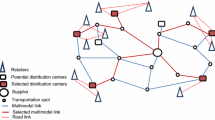Abstract
With the rapid rise of the Internet, China’s e-commerce has also flourished. The development of e-commerce has led to an increase in the volume of logistics and distribution. The further development of e-commerce has also placed higher demands on the timeliness of logistics and distribution. The competition of e-commerce companies has shifted from the competition between business models to the competition between logistics services. The scientific and rational distribution site selection planning is the prerequisite and guarantee for the efficient operation of logistics distribution network. To balance the contradiction between logistics distribution speed and distribution cost has become the key to competition among e-commerce companies. This paper analyzes the current network structure and distribution mode of e-commerce logistics city distribution, and analyzes and discusses the problems existing in current e-commerce logistics city distribution. Furthermore, the bi-level programming is studied. According to the characteristics of the bi-level programming problem, the genetic algorithm flow suitable for bi-level programming is proposed. The bi-level programming model of urban distribution service network site selection with limited lines is proposed. Through the verification of the genetic algorithm in this paper, the proposed method can plan a reasonable service site location layout and distribution models and path selection. The results show that the average daily fuel cost can be reduced by 37.6%, and the transportation distance and fuel cost can be optimized best.




Similar content being viewed by others
References
Stanimirović PS, Ćirić MS, Kazakovtsev LA et al (2011) Single-facility weber location problem based on the lift metric. Mathematics 27(2):175–190
Daskin MS, Maass KL (2015) The p-median problem. In: Location science
Siami M, Motee N (2016) Tractable approximation algorithms for the NP-hard problem of growing linear consensus networks. In: American control conference. IEEE, pp 6429–6434
Sadati EH (2015) New methods for solving a vertex p-center problem with uncertain demand-weighted distance: a real case study. Int J Ind Eng Comput 6(2):253–266
Ferone D, Festa P, Napoletano A, Resende MGC (2017) A new local search for the p-center problem based on the critical vertex concept. In: Battiti R, Kvasov D, Sergeyev Y (eds) Learning and intelligent optimization (LION)
Rabie HM, El-Khodary IA, Tharwat AA (2013) A particle swarm optimization algorithm for the continuous absolute p-center location problem with Euclidean distance. Int J Adv Comput Sci Appl 4(12):101–106
Yelbay SB, Birbil I, Bülbül LK (2014) The set covering problem revisited: an empirical study of the value of dual information. J Ind Manag Optim 11(2):575–594
Crawford B, Soto R, Cuesta R et al (2014) Application of the artificial bee colony algorithm for solving the set covering problem. Sci World J 2014(1):189164
Zade AE, Sadegheih A, Lotfi MM (2014) A modified NSGA-II solution for a new multi-objective hub maximal covering problem under uncertain shipments. J Ind Eng Int 10(4):185–197
Nobili P, Ceria S, Sassano A (1998) Set covering problem. In: Annotated bibliographies in combinatorial optimization, pp 415–428
Laporte G (2009) Fifty years of vehicle routing. Transp Sci 43(4):408–416
Dechampai D, Tanwanichkul L, Sethanan K et al (2017) A differential evolution algorithm for the capacitated VRP with flexibility of mixing pickup and delivery services and the maximum duration of a route in poultry industry. J Intell Manuf 28(6):1357–1376
Alba E, Dorronsoro B (2006) Computing nine new best-so-far solutions for Capacitated VRP with a cellular genetic algorithm. Inf Process Lett 98(6):225–230
Munawar A, Wahib M, Munetomo M et al (2009) Implementation and optimization of cGA+LS to solve capacitated VRP over cell. Int J Adv Comput Technol 1(2):16–28
Benjamin AM, Beasley JE (2013) Metaheuristics with disposal facility positioning for the waste collection VRP with time windows. Optim Lett 7(7):1433–1449
Expósito A, Raidl GR, Brito J et al (2018) GRASP-VNS for a periodic VRP with time windows to deal with milk collection. In: Computer aided systems theory—EUROCAST 2017
Zhang Y, Ji G, Wang S et al (2015) An improved GA for solving multiple depot VRP. Int Ind Inf Comput Eng Conf 12(1):30–32
Song Q, Feng H, Liu L (2016) Multiple-depot food transport vehicle routing genetic algorithm based on two-stage fuzzy clustering. Adv J Food Sci Technol 10(1):31–36
Zhang Q, Zhang C (2018) An improved ant colony optimization algorithm with strengthened pheromone updating mechanism for constraint satisfaction problem. Neural Comput Appl 30(10):3209–3220
Yousefikhoshbakht M, Didehvar F, Rahmati F (2014) Solving the heterogeneous fixed fleet open vehicle routing problem by a combined metaheuristic algorithm. Int J Prod Res 52(9):2565–2575
Yu VF, Jewpanya P, Redi ANP (2016) Open vehicle routing problem with cross-docking. Comput Ind Eng 94(2):6–17
Ismail Z, Irhamah (2012) Adaptive Heuristics for Solving VRP with stochastic demands. J Appl Sci 8(18):3228–3234
Calvet L, Pagès-Bernaus A, Travesset-Baro O et al. (2016) A simheuristic for the heterogeneous site-dependent asymmetric VRP with stochastic demands. In: Advances in artificial intelligence. Springer, pp 408–417
Gaur DR, Mudgal A, Singh RR (2018) Improved approximation algorithms for cumulative VRP with stochastic demands. Discrete Appl Math. https://www.sciencedirect.com/science/article/pii/S0166218X18300696
Song Q, Gao X, Santos ET (2016) A food chain algorithm for capacitated vehicle routing problem with recycling in reverse logistics. Int J Bifurc Chaos 25(14):1540031
Acknowledgements
This work was supported by Soft Scientific Research Projects in Henan Province, China (ID: 172400410013), Special Project on Innovation Method Work of China Ministry of Science and Technology (ID: 2017IM060100), Henan Province Philosophy and Social Affairs Office Planning Project (2016G013), CERNET Innovation Project (ID: NGII20160902), Key Scientific Research Projects in Henan Province, China (ID: 17A630016). The authors declare that there is no conflict of interest with any financial organizations regarding the material reported in this manuscript.
The authors do not have any possible conflicts of interest.
Author information
Authors and Affiliations
Corresponding author
Additional information
Publisher's Note
Springer Nature remains neutral with regard to jurisdictional claims in published maps and institutional affiliations.
Rights and permissions
About this article
Cite this article
Guo, K. Research on location selection model of distribution network with constrained line constraints based on genetic algorithm. Neural Comput & Applic 32, 1679–1689 (2020). https://doi.org/10.1007/s00521-019-04257-y
Received:
Accepted:
Published:
Issue Date:
DOI: https://doi.org/10.1007/s00521-019-04257-y




